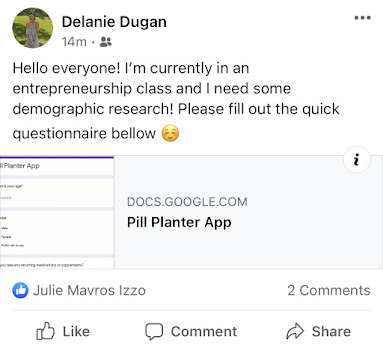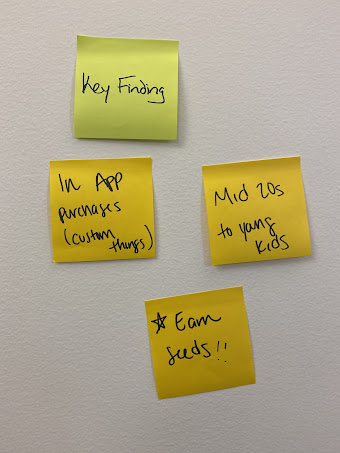November 7th, 2020
We started our day with a short lecture on the process we should progress through over the weekend and then got to work!
Our first step was to figure out the business model canvas. With 9 different segments to work through it took some time for us to work out each section. We developed our demographic, payment features, and resources.
Note from Meeting with Mata:
- Adjust age demographic
- How is this different? - Offers a reward
- Remove the real-life plant option (diverges from an original idea)
- Focus on this as an interactive game (different plant features and additions)
- Research game development and how they engage “leveling up”
- Ask people how many prescriptions do people take?
- Maybe too many plants potentially? - Personal preference
- Ask about times (when they take meds)
Our next step was to collect some demographic research. We each posted on our Instagram, Snapchat, and Facebook. We started by making a list of questions and created a Google Questionnaire. We weren’t able to easily add the link to Instagram, so we chose a few questions and added them to the story. Here is a screen recording of the Instagram questions, Snapchat post, and Facebook update.
Snapchat
Instagram
Facebook
Here were the questions from the Google Form:
After a quick trip to Central Market, we began to look through the finances while we wait for more survey results to come in. Based on our business model canvas our projected expenses are on
- App Development and Design
- Marketing and Advertising
- Partnership and Distribution
Lecture Break:
We grouped back together with everyone to hear from Professor Mata. In our lecture, we covered the importance of finalizing our MVP so we can receive feedback and make adjustments.
We also learned about the judging criteria. The topics are as followed:
- Problem and Validation - MVP
- Execution and Design Solution - Solution interaction
- Business Model - cost, targets market, alternatives, and competition
- Next 4 weeks - assumptions and hypothesis
Professor Mata also encouraged us to make a to-do list of things that need to be done, what’s in the works, and what is finished. We also added a waiting section for things that need to be done but are dependent on something else that needs to be finished as well as a key findings column.
While Lexi stayed back to continue working on finance research, Dwight, Hannah, and I walked around Lancaster for some in person questions. We stopped a handful of people and shared with them our idea and asked them the Google Form Questions.
After our walk around Lancaster City, we updated our to-do list. We added in some other tasks to complete as well as some key findings.
Our biggest development was on the key findings. After closing down the survey we had a final idea of what age demographic we were looking for. Between social media and the Google Form, we heard back from a total of 185 people!
Here are the stats from the Google Form:
Dwight is going to work on crunching all the numbers so we get our overall results.
A big development we had was on how our app will make money. Our app has grown to a Tamagotchi style avatar with in-app purchases of different accessories. We also developed the idea of having seeds to use for buying the accessories. The seeds are earned after you successfully complete the entire time span of your prescription and they can also be purchased.
Our next (and very troubling at first) step was to work out the finances. We had to enlist Professor Mata (and Hannah's dad) for some support on how to work on the specifics. Our fixed rate to use to keep the app up in production is $40,398/year. This includes having the app in both Apple and Google App Stores, IT support, server space, functionality, etc. To get our app out in the real world as a completely usable platform is $66,000. This includes the designer, developers, feature capabilities (geolocate, scannability, user profiles). A strong, productive app has a projected download of 500/day which is 182,500/year. Apps that use free downloads make about $5,000/month at the start. The break down of that income is with 2¢ revenue/view for $3,650 and seed upgrade feature roughly calculated to be $1,350. With these calculations, for us to break even will take 1 year and 10 months. A pivotal point to lessen the time to break even is as the app becomes more popular, our ad revenue and seed purchases will increase.
Here is the article Professor Mata shared with us:
Here's a messy, but effective break down of the math:
We ended the night working out the presentation. Hannah made a rough layout of the content title for each of the slides and we all worked on filling the info in. We worked late into the night trying to finish up or presentation and other visual content we want to add. Tomorrow our focus is to tie up the loose ends and practice, practice, practice!






















No comments:
Post a Comment